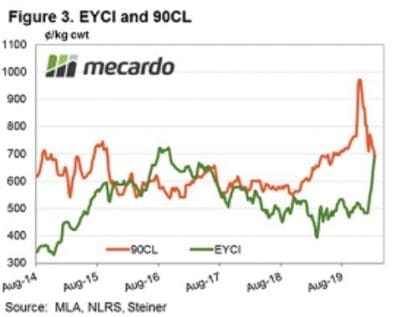WITH livestock and meat market prices moving sharply in opposite directions over the past month, substantial losses are looming for Australian beef processors this year, market analysts told an industry audience in Brisbane this morning.
Rates of slaughter across eastern Australian have dropped below five-year averages in recent weeks, highlighting the slowing in processor demand in the face of high domestic cattle prices, softening export and domestic beef prices and concerns around the ongoing spread of coronavirus impacting global growth and weighing on international beef markets.
Addressing Herron Todd White’s annual rural property breakfast, Mecardo analyst Matt Dalgleish said the 90CL benchmark beef export indicator dropped back below 700¢/kg CIF over the week, pressured by ongoing concerns over Chinese beef demand issues and higher NZ imported grinding beef supply into the US.
For the first time since the heavy restocking episode of the 2016/17 season, the EYCI had moved to a premium over the 90CL imported beef price, he said.
As this Mecardo graph shows, during a period of low cattle prices in Australia in 2014-15, there was high beef demand out of the US as it was recovering from its own drought, pushing demand for Australian 90CL grinding beef high higher, and creating a big gap in relative price between 90CL and the EYCI.
 “When Australia went through its own restocking phase in 2016-17, the EYCI got to a premium over 90CL beef, but as of yesterday, the EYCI closed at 718c/kg, and 90CL beef was back to 685c/kg CIF – again pushing the EYCI to a premium over grinding beef, for the first time since 2016-17,” he said.
“When Australia went through its own restocking phase in 2016-17, the EYCI got to a premium over 90CL beef, but as of yesterday, the EYCI closed at 718c/kg, and 90CL beef was back to 685c/kg CIF – again pushing the EYCI to a premium over grinding beef, for the first time since 2016-17,” he said.
Asked by Beef Central about the big swings in cattle price versus meat prices, Mr Dalgleish used Mecardo’s theoretical processor margin calculation on beef to illustrate the recent trend.
“Certainly last year was a relatively good year for processors, historically, but there is a strong relationship between the female slaughter ratio (or rebuild) and processor margins,” he said.
“Using our model, we’re forecasting that processors are likely to go through to a $60 per head loss average loss on slaughter cattle this year, assuming it continues to rain.
“But if you contrast that to previous drought/rebuild cycles, the losses to processors some months got to as much as $150 a head, through the year,” he said.
“We’re certainly thinking this year with the tighter scenario compared with the previous rebuild in 2016-17, suggesting there will be plenty of pain going forward for processors this year – given where supply is and what’s shaping up (seasonally) to be a good year.”
The Australian beef industry could be somewhat insulated from the effects of coronavirus, he said.

Mecardo’s Matt Dalgleish
Females as a percentage of total slaughter numbers could potentially head to 42-43 percent this year, after reaching 57pc last year, as a result of rain and a beef herd at 30 year lows. As a result, high restocker demand could insulate against the market impact of coronavirus.
Discussing likely impacts on meat supply and demand this year, Mr Dalgleish said while African Swine Fever had largely been ‘forgotten about’ since the arrival of coronavirus, ASF had not gone away, and was continuing to drive global livestock and meat markets.
Latest estimates suggested around 240 million Chinese pigs will have died from the disease by the end of this year, out of a total population of 440 million.
“That suggests there will be a protein gap of almost 25 million tonnes in China this year. To put that in perspective, the whole Australian beef industry – export and domestic – accounts for 2.1 million tonnes of beef a year, so China’s protein deficit is a figure 12 times the size,” he said.
Even with additional importation of chicken, beef and pork, and some expansion in domestic chicken production, there was still a 16 million tonne deficit in meat protein in the Chinese market this year, Mr Dalgleish said.
Australian beef exports to China had remained incredibly high for January – which is normally a time of year when trade is quieter after deliveries concluded for Chinese New Year.
However with the latest developments around coronavirus, the impact on February trade remained a little unknown.
“It still remains to be seen how the spread of coronavirus will play out globally, particularly with regard to the impact on beef export demand, but more clarity will be available in the coming weeks as we get access to the February trade figures,” he said.

Well done. Comprehensive summary of the current drivers of the beef market. This makes for a challenging (interesting) time for beef and red meat in general. Will the negatives over power the market, or will the herd rebuild, tight supply and growing demand (ASF) carry the day? My bet is on the latter.